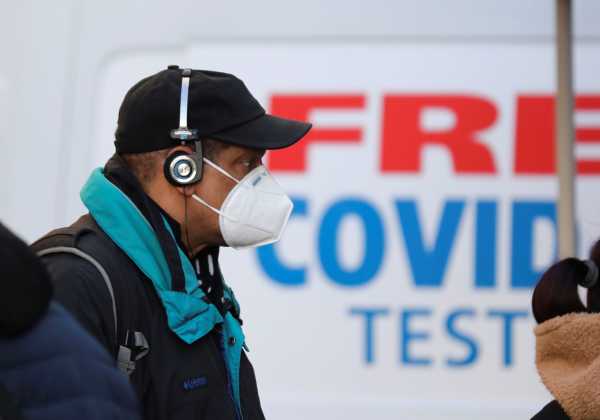
As of this month, a limited number of rapid Covid-19 tests and N95 face masks are available for free in the US as part of a new Biden administration effort to combat the omicron variant.
Rapid, at-home antigen tests can be ordered by mail using covidtests.gov, though there’s a limit of only four tests per household. The tests are a quick and easy way to check for a Covid-19 infection, but they’re not perfect — false negatives can be a problem, and omicron presents additional difficulties, such as the possibility that the variant causes the virus to replicate more in the throat that in nasal passages.
N95 or KN95 respirators, meanwhile, are increasingly becoming widely available after critical shortages earlier in the pandemic. The masks are highly effective at preventing Covid-19 spread — much more so than cloth masks — and are starting to become available for free at pharmacies and community health centers as part of a new Biden administration program.
As Vox’s Muizz Akhtar explained this week, the masks are coming from the National Strategic Stockpile and are already available at some locations in the US, with more on track to be delivered by early February.
But while respirators and rapid tests are both important tools to combat the omicron variant, limited availability — and cost, when they’re not being delivered for free by the government — presents a challenge.
Here’s how to make the most out of your free masks and tests.
What’s the best way to conserve N95 respirators?
N95 respirators, along with the closely related KN95 and KF94 models, are far and away your best option at this point in the pandemic, and luckily, they can be reused.
Even if you have only a limited number on hand — beyond the free masks provided by the administration, they cost between $1 and $3 apiece — you should be wearing one when you go out in public, Chris Cappa, the chair of the University of California Davis civil and environmental engineering department, told Vox.
According to Cappa, it’s best to use the highest possible protection in any circumstance where you’ll be in public, no matter the size of the crowd.
“One reason that the risk is lower in a less crowded place is because there’s fewer people, and so the probability of any one person having Covid goes down,” Cappa told Vox, “but if that one person has it, then your risk is no different than if you were in a crowded room with 100 people and one person has it.”
In a medical setting, N95s and similar masks are often single-use, but that doesn’t need to be the case for general wear. To make your free masks last longer, Cappa recommends rotating between multiple masks to give them time to decontaminate between uses.
The best way for people in non-medical settings to sanitize a used respirator is to leave it in a paper bag for three to four days, or even longer. The coronavirus dies off fairly quickly, and the mask is perfectly safe to be reused.
Another practice that will help conserve the respirators is limiting the number of times you put on and remove the mask while wearing it.
“The more often that you take them on and off, the more stretched out they tend to get,” Cappa said. “And so if you can kind of decrease the number of times that you would take it on and off, the longer it will last because one of the ways that N95s outside the specific medical or occupation situations kind of go bad is that the straps get stretched out, they don’t fit very well anymore.”
Fit is critical to proper mask function; if air is escaping or entering through gaps in the respirator (or any other mask you might use), then it’s not protecting you or others adequately against Covid-19.
Consequently, the main indication that your respirator should be decommissioned is fit — if the straps are loose and the nose bridge isn’t tightly conforming to your nose. You should try to touch the masks at the edges and by the straps, and be mindful of touching it as little as possible, Cappa said, but the main way the mask’s effectiveness will degrade is through improper fit, not necessarily material denigration.
One way to see if it’s time for a new mask is to refrigerate a small mirror for 15 minutes, then hold it up to your face while wearing the respirator and see if any condensation forms. If so, that indicates that your breath is seeping out of the respirator — and that particles and aerosols can get in — and it’s time to discard it, Cappa told Vox.
When should I use my free antigen tests?
With antigen tests, it’s important to remember a few things: First, tests are a snapshot in time; second, they indicate whether you’re infectious rather than simply whether you have Covid-19; and third, testing is about protecting others, not just knowing if you have the virus, experts Lisa Lee and Gigi Gronvall told Vox.
Four tests is “clearly not enough to get us very far,” Lee, an epidemiologist and Virginia Tech’s associate vice president for research and innovation, said in a phone interview, though there are additional free tests available at testing centers with private health insurance and Medicaid and local health departments.
In a perfect world, according to Lee, “we could test every day before we leave the house to know when we are contagious.”
However, she told Vox via email, “because tests are limited, we have to prioritize their use, which I’d suggest is when we risk exposing someone vulnerable or going to a gathering where you could expose a large number of people.”
If you’re planning to visit an elderly relative, for example, it’s important to test before interacting with them. In an interview with Vox, Gronvall, a senior scholar with the Center for Health Security at the Johns Hopkins School of Public Health, emphasized that timing is important and that you should take the test as close as possible to a gathering, as the amount of virus in your body can change over the course of a day.
“Really, it’s about helping others at this point,” she said in a phone interview.
Another good reason to use a rapid test is if you know you’ve been exposed to the virus but aren’t showing symptoms. Even if you’re asymptomatic, Gronvall said, it’s important to test after exposure, since you could still be infectious.
“Not everybody is going to have symptoms at all but they still may have a lot of virus in their nose,” Gronvall said. “The test doesn’t care if you have symptoms or not, it’s looking for the virus.”
Since each person is different, there’s no hard and fast rule for how long it takes for someone to develop enough viral proteins in their body to become infectious, but testing three to five days after exposure will give you the best indication of whether or not you are, Lee told Vox.
If you’re short on tests, though, there are also circumstances where it makes sense to hold off. If you have Covid-19 symptoms or feel unwell, Lee told Vox, it’s best to isolate for seven to ten days and test at the end of the isolation period to make sure you’re not infectious. If you’re very ill, seek medical attention; you’ll get tested at the clinic or hospital anyway, so there’s no need to use one of your antigen tests.
The good news is that while test availability is somewhat limited for now, that could change in the near future. In addition to the 500 million tests free tests the Biden administration announced it would send out last month, another 500 million should be available in the spring.
Gronvall also told Vox that she anticipates a much larger testing rollout in coming weeks to places like schools and local health departments.
There will likely be a variety of brands of tests sent out by the White House in the coming weeks, all of which have been authorized for emergency use by the FDA. No matter which type you get, Lee said, you should follow the manufacturer’s instructions for use. “The test is approved for the way in which it was developed,” Lee stressed, though some experts also say throat swabs make sense because omicron could multiply more in the throat than it does in the nose.
Before using a test, Gronvall told Vox, “it’s probably a good idea to blow your nose, make sure there’s not any old stuff up there.” For extra help, many test manufacturers have video instructions available.
But testing alone isn’t enough to stop the virus, Lee said, though it is an important tool. Protecting yourself and others also means getting fully vaccinated and using high-quality masks — like N95s — when in public.
“Only when we stop transmitting [the virus] will we stop Covid,” she said.
Will you support Vox’s explanatory journalism?
Millions turn to Vox to understand what’s happening in the news. Our mission has never been more vital than it is in this moment: to empower through understanding. Financial contributions from our readers are a critical part of supporting our resource-intensive work and help us keep our journalism free for all. Please consider making a contribution to Vox today.
Sourse: vox.com






